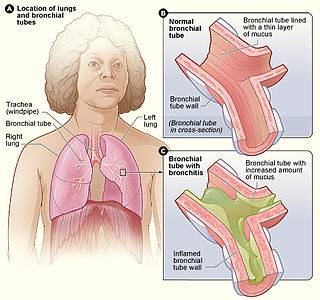
Soul Coughing was an American alternative rock band composed of vocalist/guitarist Mike Doughty, keyboardist/sampler Mark Degli Antoni, bassist Sebastian Steinberg, and drummer Yuval Gabay. Soul Coughing developed a devout fanbase and garnered largely positive response from critics. Steve Huey of AllMusic described the band as "one of the most unusual cult bands of the 1990s..." driven by frontman Mike Doughty's stream-of-consciousness poetry. Soul Coughing's sound was a willfully idiosyncratic mix of improvisational jazz grooves, oddball samples, hip hop, electronics, and noisy experimentalism". Doughty himself described the band's sound as "deep slacker jazz". The group broke up in 2000.

The common cold or the cold is a viral infectious disease of the upper respiratory tract that primarily affects the respiratory mucosa of the nose, throat, sinuses, and larynx. Signs and symptoms may appear fewer than two days after exposure to the virus. These may include coughing, sore throat, runny nose, sneezing, headache, and fever. People usually recover in seven to ten days, but some symptoms may last up to three weeks. Occasionally, those with other health problems may develop pneumonia.

Whooping cough, also known as pertussis or the 100-day cough, is a highly contagious, vaccine-preventable bacterial disease. Initial symptoms are usually similar to those of the common cold with a runny nose, fever, and mild cough, but these are followed by two or three months of severe coughing fits. Following a fit of coughing, a high-pitched whoop sound or gasp may occur as the person breathes in. The violent coughing may last for 10 or more weeks, hence the phrase "100-day cough". The cough may be so hard that it causes vomiting, rib fractures, and fatigue. Children less than one year old may have little or no cough and instead have periods where they cannot breathe. The incubation period is usually seven to ten days. Disease may occur in those who have been vaccinated, but symptoms are typically milder.

A cough is a sudden expulsion of air through the large breathing passages which can help clear them of fluids, irritants, foreign particles and microbes. As a protective reflex, coughing can be repetitive with the cough reflex following three phases: an inhalation, a forced exhalation against a closed glottis, and a violent release of air from the lungs following opening of the glottis, usually accompanied by a distinctive sound.

Cold medicines are a group of medications taken individually or in combination as a treatment for the symptoms of the common cold and similar conditions of the upper respiratory tract. The term encompasses a broad array of drugs, including analgesics, antihistamines and decongestants, among many others. It also includes drugs which are marketed as cough suppressants or antitussives, but their effectiveness in reducing cough symptoms is unclear or minimal.

Benadryl is a brand of various antihistamine medications used to stop allergies, whose content varies in different countries, but which includes some combination of diphenhydramine, acrivastine, and/or cetirizine.

Vicks is an American brand of over-the-counter medications owned by the American companies Procter & Gamble and Kaz Incorporated. Vicks manufactures NyQuil and its sister medication, DayQuil as well as other medications in the "Quil" line. Vicks also produces the Formula 44 brand of cough medicines, cough drops, Vicks VapoRub, and a number of inhaled breathing treatments. For much of its history, Vicks products were manufactured by the family-owned company Richardson-Vicks, Inc., based in Greensboro, North Carolina. Richardson-Vicks, Inc., was eventually sold to Procter & Gamble in 1985. Procter & Gamble divested the Vicks VapoSteam U.S. liquid inhalant business and sold it to Helen of Troy in 2015.
Benzonatate, sold under the brand name Tessalon among others, is a medication that is used for the symptomatic relief of cough. A 2023 systematic review found that there is inadequate evidence to support the effectiveness and safety of benzonatate for cough and highlighted rising safety concerns. Benzonatate is taken by mouth. Effects generally begin within 20 minutes and last 3 to 8 hours.

Phenyltoloxamine is an antihistamine with sedative and analgesic effects. It is available in combination with other drugs such as paracetamol (acetominophen).

Dextromethorphan (DXM) is a cough suppressant used in many cough and cold medicines. It affects serotonin, norepinephrine, NMDA, and sigma-1 receptors in the brain, all of which have been implicated in the pathophysiology of depression. In 2022, the FDA approved a formulation of it combined with bupropion named Auvelity to serve as a rapid acting antidepressant in patients with major depressive disorder.

Benylin is a brand name owned by Kenvue for a range of cough, cold and flu medications. Some Benylin products also contain codeine, which is used to treat pain, cough and diarrhea.

Halls is a British brand of a mentholated cough drop owned by Mondelēz International since 2015. In 2016, it was one of the biggest selling branded over-the-counter medications sold in Great Britain, with sales of £32.5 million.

Lean, also known as purple drank, purp, sizzurp, syrup, and several other names, is a recreational drug beverage, prepared by mixing prescription-grade cough or cold syrup containing codeine and promethazine with a soft drink. The beverage originated in Houston and is popular in hip hop culture, especially within the Southern United States.

Vicks VapoRub is a mentholated topical ointment, part of the Vicks brand of over-the-counter medications owned by the American consumer goods company Procter & Gamble. VapoRub is intended for use on the chest, back and throat for cough suppression or on muscles and joints for minor aches and pains. Users of VapoRub often apply it immediately before sleep.

Codeine is an opiate and prodrug of morphine mainly used to treat pain, coughing, and diarrhea. It is also commonly used as a recreational drug. It is found naturally in the sap of the opium poppy, Papaver somniferum. It is typically used to treat mild to moderate degrees of pain. Greater benefit may occur when combined with paracetamol (acetaminophen) or a nonsteroidal anti-inflammatory drug (NSAID) such as aspirin or ibuprofen. Evidence does not support its use for acute cough suppression in children or adults. In Europe, it is not recommended as a cough medicine in those under 12 years of age. It is generally taken by mouth. It typically starts working after half an hour, with maximum effect at two hours. Its effects last for about four to six hours. Codeine exhibits abuse potential similar to other opioid medications, including a risk of habituation and overdose.

Cloroqualone is a quinazolinone-class GABAergic and is an analogue of methaqualone developed in the 1980s and marketed mainly in France and some other European countries. It has sedative and antitussive properties resulting from its agonist activity at the β subtype of the GABAa receptor and sigma-1 receptor, and was sold either alone or in combination with other ingredients as a cough medicine. Cloroqualone has weaker sedative properties than methaqualone and was sold for its useful cough-suppressing effects, but was withdrawn from the French market in 1994 because of concerns about its potential for abuse and overdose.

Clofedanol (INN) or chlophedianol (BAN), sold under the brand name Ninjacof among others, is a centrally acting cough suppressant used in the treatment of dry cough. Clofedanol has local anesthetic, antispasmodic, and antihistamine properties, and may have anticholinergic effects at high doses.

Levodropropizine is a cough suppressant. It is the levo isomer of dropropizine. It acts as a peripheral antitussive, with no action in the central nervous system. It does not cause side effects such as constipation or respiratory depression which can be produced by opioid antitussives such as codeine and its derivatives.

Butamirate is a cough suppressant. It has been marketed in Europe and Mexico, but not in the United States.

Bronchitis is inflammation of the bronchi in the lungs that causes coughing. Bronchitis usually begins as an infection in the nose, ears, throat, or sinuses. The infection then makes its way down to the bronchi. Symptoms include coughing up sputum, wheezing, shortness of breath, and chest pain. Bronchitis can be acute or chronic.


















